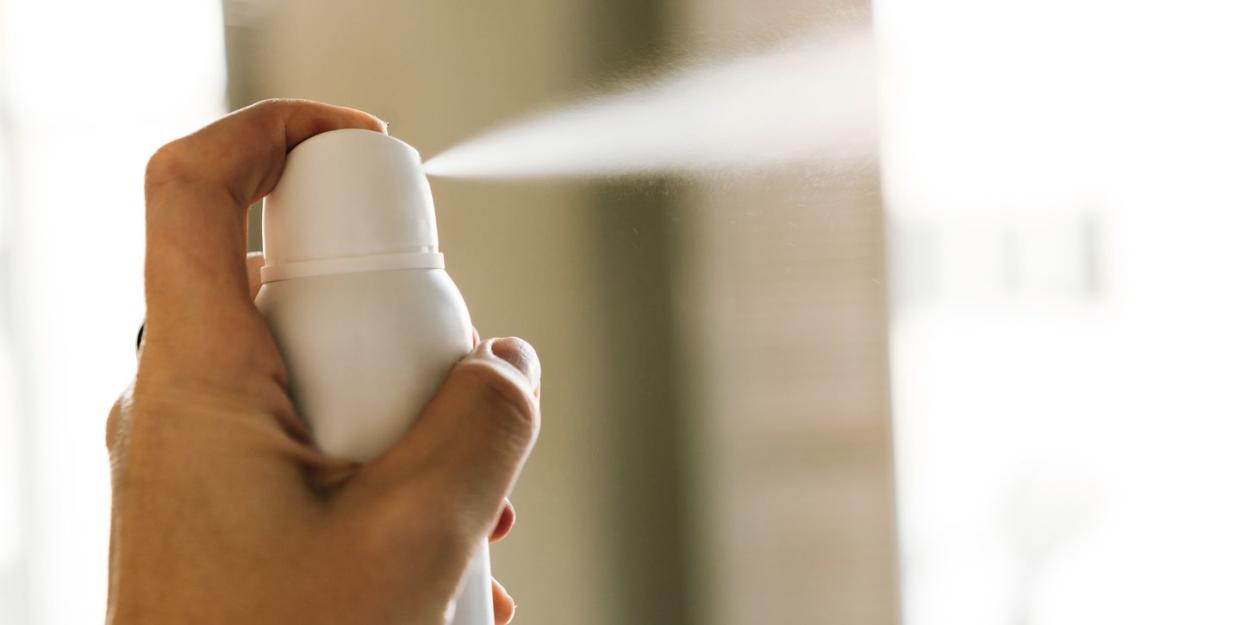Don't Make This One BIG Dry Shampoo Mistake

Dry shampoo is the "it girl" of time-saving beauty products. It's perfect for when you just don't have time to get a wash in in between everything else on your to-do list, but you still want to give your hair a boost.
Meet Our Experts: Kieron Fowles, celebrity hairstylist, Clint Dunlap, hairstylist and colorist based in New York and Florida
These days, you can find dry shampoo in several forms, including dry liquid, dry foam, or a spray, which is the most common option. You can even buy tinted dry shampoos in the event your colorist is too booked and busy to pencil you in.
Convenient as dry shampoo is, there's still some discourse on the right way to apply it, as some experts argue that you should only apply it to your roots, while others maintain that all of your hair is fair game. Not to mention the long-time struggle of ending up with roots that look like you just painted them with chalk.
If you want to know exactly how to apply dry shampoo along with a few other pro tips, read on for all the details.
What is dry shampoo?
"Dry shampoo is an absorbent spray made up of starch or alcohol components that eliminate and soak up excess natural oil, grease, dirt, and sweat or smell produced from the hair follicles called sebum," says celebrity hairstylist Kieron Fowles.
Think of it as a water-free powder spray that will give your hair a fresh smell, look, and feel in between your washes. But to be clear, it's not the same as actual shampoo, so while it may be a convenient alternative to a full wash day occasionally, it's also important to know when it's time to break out the suds.
What are the benefits of using dry shampoo?
Per Fowles, there are plenty of reasons why someone might invest in a dry shampoo that aren't just limited to convenience.
It can save you time from having to wash your hair frequently.
It preserves natural oils.
It serves as a quick fix for refreshing your hair.
It adds volume and texture to fine or thin hair.
It improves the smell of your hair between washes.
It can cover hair regrowth between color appointments.
While these points are all promising, it's important to remember that hair products don't work the same for everyone, so make sure you do your own investigating before buying one. "Dry shampoo is not one size fits all," says hairstylist Clint Dunlap. "It’s about finding the one that works best for you, your hair type, and your hair needs." To experiment with different products, he recommends buying travel-sized versions of dry shampoo to get a feel for the product before buying a full-sized one.
How often can I use dry shampoo?
While dry shampoo is supposed to give you a refresh, it can also be the source of build-up if you're not careful. "If you overuse dry shampoo, your hair may become more vulnerable to breakage or feel dry and brittle," explains Fowles. "The health of your scalp could be affected from product build-up and start to itch, cause dandruff, or inflammation."
To keep your scalp healthy, he suggests using dry shampoo only one to two days a week or using it as a finishing spray for a small touch of volume. You can also wash your hair two to three times a week and use the dry shampoo in between days to avoid hair from falling flat from greasiness.
If you have an active lifestyle or a busy schedule, you might also be prone to greasy hair as a result of frequent movement, says Dunlap, so consider timing your usage with your schedule.
How to apply dry shampoo the right way
Dry shampoo is pretty straightforward to use, and it requires zero prep time if you're rocking second-day hair. Here's how it works in three simple steps.
Step 1: Once you've selected your preferred dry shampoo, give the can or bottle a good shake, and hold it about six to ten inches away from your hair.
Step 2: To dry hair, apply the product in big sections in a sweeping motion to target oily areas at the root. You can also spray it to the mid-sections and ends if you want to achieve volume and texture after styling.
Step 3: Wait about 30 seconds before massaging your hair with your fingers or brushing it. Giving it a few moments to sit after the initial application will allow it to activate and cleanse your hair. You can apply more if you'd like—just be careful of overdoing it.
Can anyone use dry shampoo?
Unfortunately, some people will benefit from dry shampoo more or less than others. Fowles notes that dry shampoo will likely help those who get oily or greasy scalp easily. On the flip side, people with sensitive scalps, hair loss, dandruff, seborrheic dermatitis, and psoriasis of the scalp may not benefit as much.
If you're unsure whether dry shampoo will work for you, consult a hairstylist or dermatologist to address any concerns.
You Might Also Like

